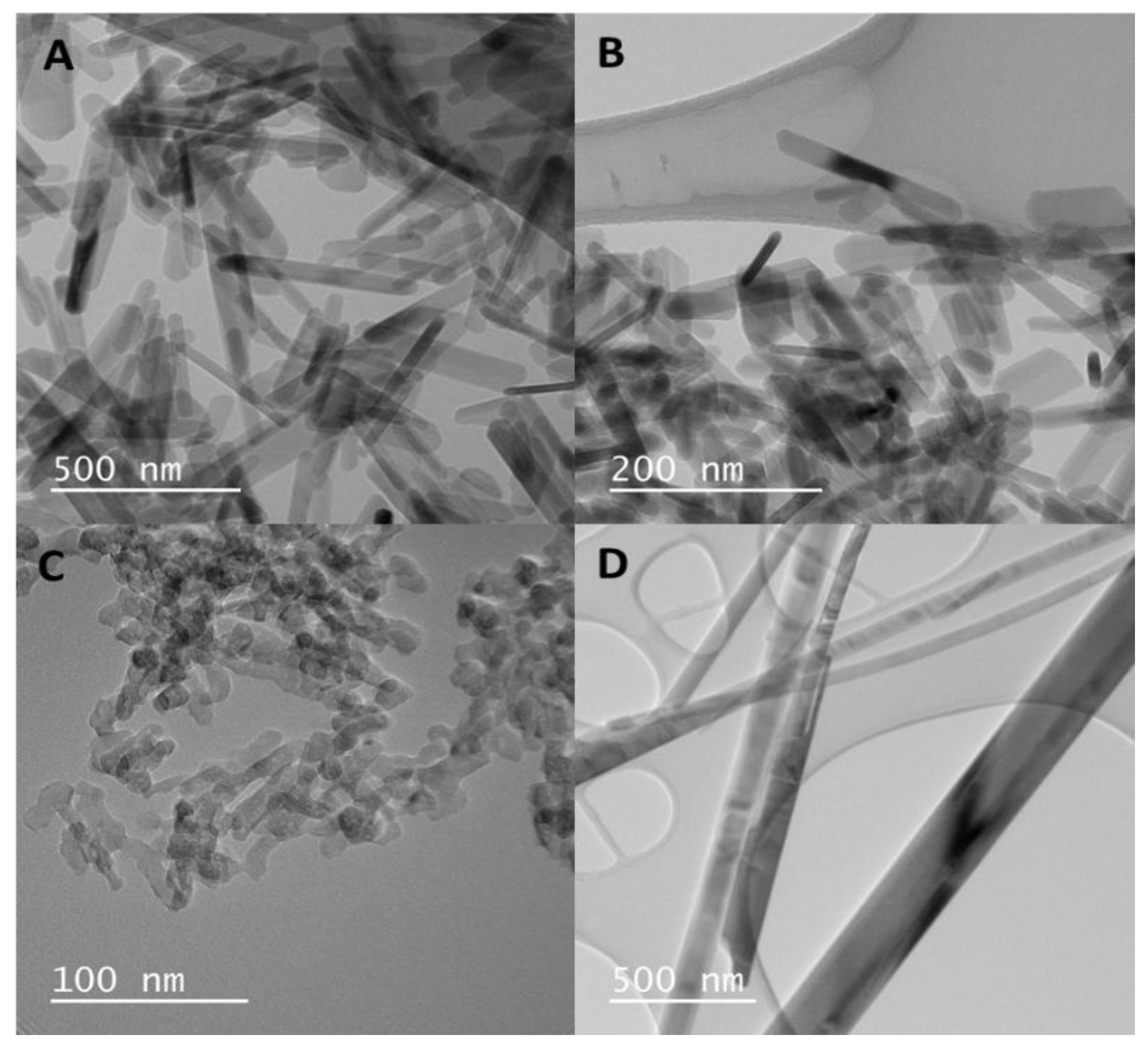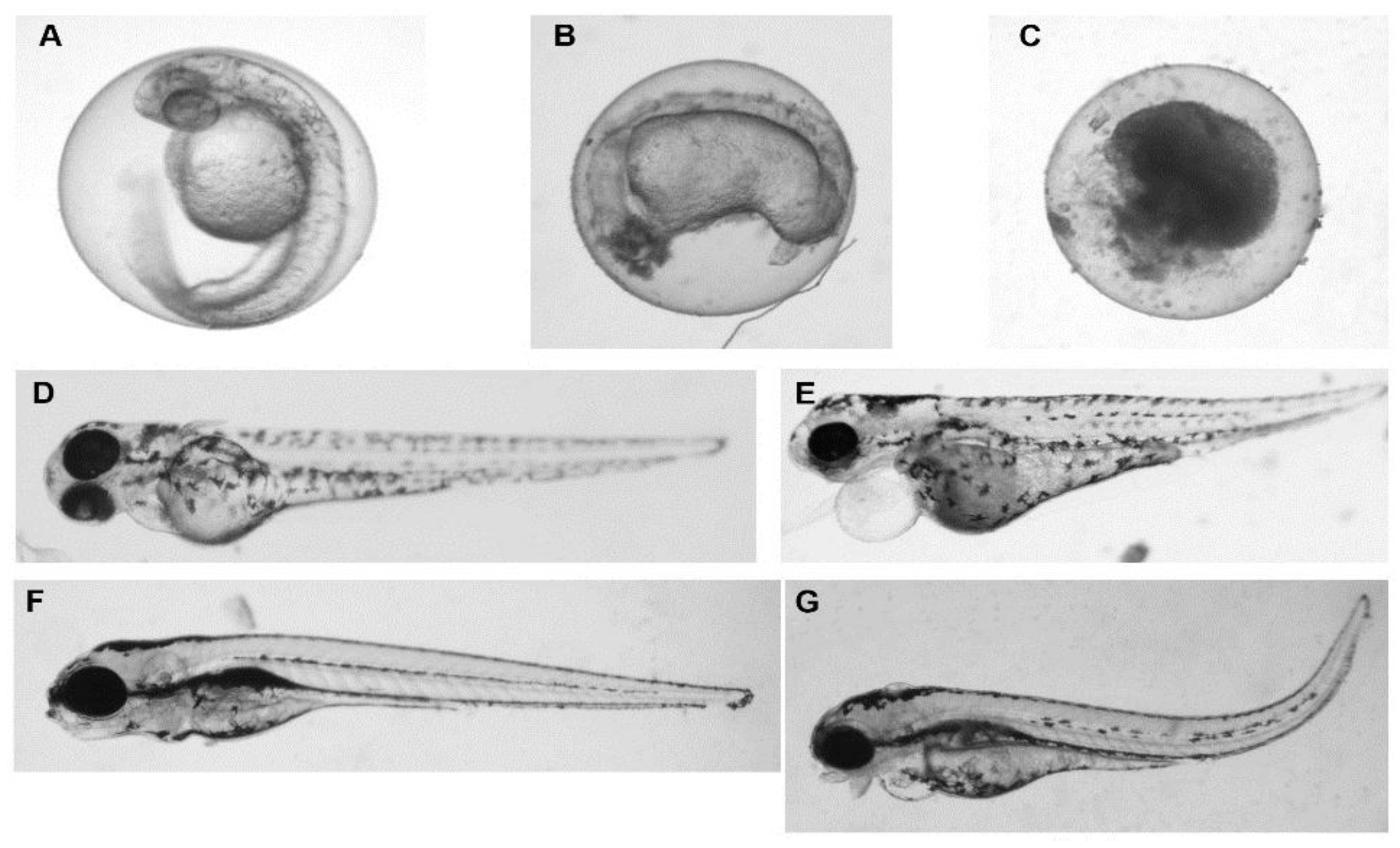The Influence of Hydroxyapatite Nanoparticle Morphology on Embryonic Development in a Zebrafish Exposure Model
Abstract
:1. Introduction
2. Results and Discussion
3. Conclusions
4. Materials and Methods
4.1. Particle Preparation and Characterization
4.2. Zebrafish Embryo Exposure to HANPs
Acknowledgments
Author Contributions
Conflicts of Interest
References
- Donaldson, K.; Stone, V.; Tran, C.L.; Kreyling, W.; Borm, P.J. Nanotoxicology. Occup. Environ. Med. 2004, 61, 727–728. [Google Scholar] [CrossRef] [PubMed]
- Nel, A.; Xia, T.; Madler, L.; Li, N. Toxic potential of materials at the nanolevel. Science 2006, 311, 622–627. [Google Scholar] [CrossRef] [PubMed]
- Sharifi, S.; Behzadi, S.; Laurent, S.; Forrest, M.L.; Stroeve, P.; Mahmoudi, M. Toxicity of nanomaterials. Chem. Soc. Rev. 2012, 41, 2323–2343. [Google Scholar] [CrossRef] [PubMed]
- De Groot, K. Bioceramics consisting of calcium phosphate salts. Biomaterials 1980, 1, 47–50. [Google Scholar] [CrossRef]
- Dorozhkin, S.V.; Epple, M. Biological and medical significance of calcium phosphates. Angew. Chem. 2002, 41, 3130–3146. [Google Scholar] [CrossRef]
- Hak, D.J. The use of osteoconductive bone graft substitutes in orthopaedic trauma. J. Am. Acad. Orthop. Surg. 2007, 15, 525–536. [Google Scholar] [CrossRef] [PubMed]
- Huracek, J.; Spirig, P. The effect of hydroxyapatite coating on the fixation of hip prostheses. Arch. Orthop. Trauma Surg. 1994, 113, 72–77. [Google Scholar] [CrossRef] [PubMed]
- Jaffe, W.L.; Scott, D.F. Total hip arthroplasty with hydroxyapatite-coated prostheses. J. Bone Jt. Surg. Am. Vol. 1996, 78, 1918–1934. [Google Scholar] [CrossRef]
- Bloebaum, R.D.; Zou, L.; Bachus, K.N.; Shea, K.G.; Hofmann, A.A.; Dunn, H.K. Analysis of particles in acetabular components from patients with osteolysis. Clin. Orthop. Relat. Res. 1997, 338, 109–118. [Google Scholar] [CrossRef]
- Morscher, E.W.; Hefti, A.; Aebi, U. Severe osteolysis after third-body wear due to hydroxyapatite particles from acetabular cup coating. J. Bone Jt. Surg. Br. Vol. 1998, 80, 267–272. [Google Scholar] [CrossRef]
- Yamashita, K.; Yoshioka, Y.; Higashisaka, K.; Mimura, K.; Morishita, Y.; Nozaki, M.; Yoshida, T.; Ogura, T.; Nabeshi, H.; Nagano, K.; et al. Silica and titanium dioxide nanoparticles cause pregnancy complications in mice. Nat. Nanotechnol. 2011, 6, 321–328. [Google Scholar] [CrossRef] [PubMed]
- Browning, L.M.; Huang, T.; Xu, X.H. Real-time in vivo imaging of size-dependent transport and toxicity of gold nanoparticles in zebrafish embryos using single nanoparticle plasmonic spectroscopy. Interface Focus 2013, 3, 20120098. [Google Scholar] [CrossRef] [PubMed]
- Di Bona, K.R.; Xu, Y.; Ramirez, P.A.; DeLaine, J.; Parker, C.; Bao, Y.; Rasco, J.F. Surface charge and dosage dependent potential developmental toxicity and biodistribution of iron oxide nanoparticles in pregnant CD-1 mice. Reprod. Toxicol. 2014, 50, 36–42. [Google Scholar] [CrossRef] [PubMed]
- Hong, J.S.; Park, M.K.; Kim, M.S.; Lim, J.H.; Park, G.J.; Maeng, E.H.; Shin, J.H.; Kim, Y.R.; Kim, M.K.; Lee, J.K.; et al. Effect of zinc oxide nanoparticles on dams and embryo-fetal development in rats. Int. J. Nanomed. 2014, 9, 145–157. [Google Scholar]
- Chakraborty, C.; Sharma, A.R.; Sharma, G.; Lee, S.S. Zebrafish: A complete animal model to enumerate the nanoparticle toxicity. J. Nanobiotechnol. 2016, 14, 65. [Google Scholar] [CrossRef] [PubMed]
- Beliaeva, N.F.; Kashirtseva, V.N.; Medvedeva, N.V.; Khudoklinova, I.; Ipatova, O.M.; Archakov, A.I. Zebrafish as a model organism for biomedical studies. Biomed. Khimiia 2010, 56, 120–131. [Google Scholar] [CrossRef]
- Varshney, G.K.; Lu, J.; Gildea, D.E.; Huang, H.; Pei, W.; Yang, Z.; Huang, S.C.; Schoenfeld, D.; Pho, N.H.; Casero, D.; et al. A large-scale zebrafish gene knockout resource for the genome-wide study of gene function. Genome Res. 2013, 23, 727–735. [Google Scholar] [CrossRef] [PubMed]
- Pujari-Palmer, S.; Chen, S.; Rubino, S.; Weng, H.; Xia, W.; Engqvist, H.; Tang, L.; Ott, M.K. In vivo and in vitro evaluation of hydroxyapatite nanoparticle morphology on the acute inflammatory response. Biomaterials 2016, 90, 1–11. [Google Scholar] [CrossRef] [PubMed]
- King-Heiden, T.C.; Wiecinski, P.N.; Mangham, A.N.; Metz, K.M.; Nesbit, D.; Pedersen, J.A.; Hamers, R.J.; Heideman, W.; Peterson, R.E. Quantum dot nanotoxicity assessment using the zebrafish embryo. Environ. Sci. Technol. 2009, 43, 1605–1611. [Google Scholar] [CrossRef] [PubMed]
- Boix, N.P.E.; Gomez-Catalan, J.; Teixido, E.; Llobet, J.M. The zebrafish embryo as a model for studying oxidative stress effect during embryonic development. Reprod. Toxicol. 2013, 41, 21–34. [Google Scholar] [CrossRef]
- Brown, D.M.; Bangert, U.; Windle, A.H.; Walter, D.M.; Walker, G.S.; Scotchford, C.A.; Donaldson, K.; Sone, V. An in vitro study of the potential of carbon nanotubes and nanofibres to induce inflammatory mediators and frustrated phagocytosis. Carbon 2007, 45, 1743–1756. [Google Scholar] [CrossRef]
- Duffin, R.; Tran, L.; Brown, D.; Stone, V.; Donaldson, K. Proinflammogenic effects of low-toxicity and metal nanoparticles in vivo and in vitro: Highlighting the role of particle surface area and surface reactivity. Inhal. Toxicol. 2007, 19, 849–856. [Google Scholar] [CrossRef] [PubMed]
- Oberdorster, G.; Ferin, J.; Lehnert, B.E. Correlation between particle size, in vivo particle persistence, and lung injury. Environ. Health Perspect. 1994, 102, 173–179. [Google Scholar] [CrossRef] [PubMed]
- Tran, C.L.; Buchanan, D.; Cullen, R.T.; Searl, A.; Jones, A.D.; Donaldson, K. Inhalation of poorly soluble particles. II. Influence of particle surface area on inflammation and clearance. Inhal. Toxicol. 2000, 12, 1113–1126. [Google Scholar] [PubMed]
- Lee, K.J.; Nallathamby, P.D.; Browning, L.M.; Osgood, C.J.; Xu, X.H. In vivo imaging of transport and biocompatibility of single silver nanoparticles in early development of zebrafish embryos. ACS Nano 2007, 1, 133–143. [Google Scholar] [CrossRef] [PubMed]
- Xia, T.; Zhao, Y.; Sager, T.; George, S.; Pokhrel, S.; Li, N.; Schoenfeld, D.; Meng, H.; Lin, S.; Wang, X.; et al. Decreased dissolution of ZnO by iron doping yields nanoparticles with reduced toxicity in the rodent lung and zebrafish embryos. ACS Nano 2011, 5, 1223–1235. [Google Scholar] [CrossRef] [PubMed]
- Zhao, X.; Ong, K.J.; Ede, J.D.; Stafford, J.L.; Ng, K.W.; Goss, G.G.; Loo, S.C. Evaluating the toxicity of hydroxyapatite nanoparticles in catfish cells and zebrafish embryos. Small 2013, 9, 1734–1741. [Google Scholar] [CrossRef] [PubMed]
- Xu, Z.; Zhang, Y.L.; Song, C.; Wu, L.L.; Gao, H.W. Interactions of hydroxyapatite with proteins and its toxicological effect to zebrafish embryos development. PLoS ONE 2012, 7, e32818. [Google Scholar] [CrossRef] [PubMed]
- Maccormack, T.J.; Clark, R.J.; Dang, M.K.; Ma, G.; Kelly, J.A.; Veinot, J.G.C.; Goss, G.G. Inhibition of enzyme activity by nanomaterials: Potential mechanisms and implications for nanotoxicity testing. Nanotoxicology 2012, 6, 514–525. [Google Scholar] [CrossRef] [PubMed]


| Particle Morphology | Dimensions | Surface Area |
|---|---|---|
| Long Rods | 20 nm × 200 nm | 71.6 |
| Dots | 15 nm × 15 nm | 91.5 |
| Sheets | 75 nm × 30 nm | 58.6 |
| Fibers | 60 nm × 1–4 μm | 52.7 |
| Sheets | Dots | Long Rods | Fibers | Control | ||||||
|---|---|---|---|---|---|---|---|---|---|---|
| 40 mg/L | Malformed | Dead | Malformed | Dead | Malformed | Dead | Malformed | Dead | Malformed | Dead |
| Day 1 | 0% | 14% | 20% | 20% | 0% | 25% | 33% | 67% | 0% | 29% |
| Day 3 | 27% | 0% | 25% | 0% | 17% | 0% | 0% | 100% | 0% | 0% |
| Day 5 | 33% | 0% | 0% | 17% | 0% | 0% | 0% | 100% | 0% | 0% |
| Sheets | Dots | Long Rods | Fibers | Control | ||||||
|---|---|---|---|---|---|---|---|---|---|---|
| 100 mg/L | Malformed | Dead | Malformed | Dead | Malformed | Dead | Malformed | Dead | Malformed | Dead |
| Day 1 | 0% | 25% | 0% | 18% | 0% | 18% | 0% | 100% | 0% | 29% |
| Day 3 | 67% | 33% | 88% | 38% | 67% | 22% | 0% | 100% | 0% | 0% |
| Day 5 | 0% | 100% | 0% | 100% | 0% | 100% | 0% | 100% | 0% | 0% |
© 2017 by the authors. Licensee MDPI, Basel, Switzerland. This article is an open access article distributed under the terms and conditions of the Creative Commons Attribution (CC BY) license (http://creativecommons.org/licenses/by/4.0/).
Share and Cite
Pujari-Palmer, S.; Lu, X.; Karlsson Ott, M. The Influence of Hydroxyapatite Nanoparticle Morphology on Embryonic Development in a Zebrafish Exposure Model. Nanomaterials 2017, 7, 89. https://doi.org/10.3390/nano7040089
Pujari-Palmer S, Lu X, Karlsson Ott M. The Influence of Hydroxyapatite Nanoparticle Morphology on Embryonic Development in a Zebrafish Exposure Model. Nanomaterials. 2017; 7(4):89. https://doi.org/10.3390/nano7040089
Chicago/Turabian StylePujari-Palmer, Shiuli, Xi Lu, and Marjam Karlsson Ott. 2017. "The Influence of Hydroxyapatite Nanoparticle Morphology on Embryonic Development in a Zebrafish Exposure Model" Nanomaterials 7, no. 4: 89. https://doi.org/10.3390/nano7040089
APA StylePujari-Palmer, S., Lu, X., & Karlsson Ott, M. (2017). The Influence of Hydroxyapatite Nanoparticle Morphology on Embryonic Development in a Zebrafish Exposure Model. Nanomaterials, 7(4), 89. https://doi.org/10.3390/nano7040089





